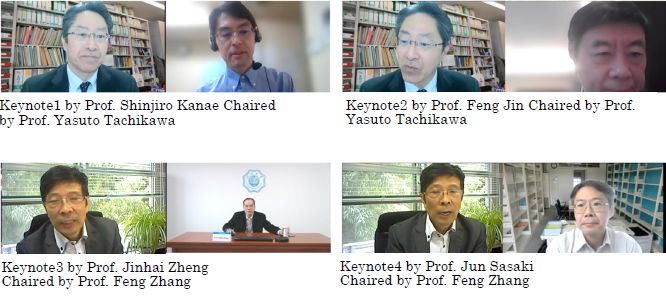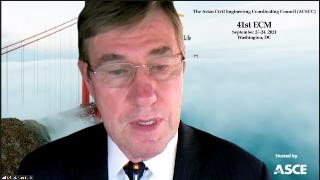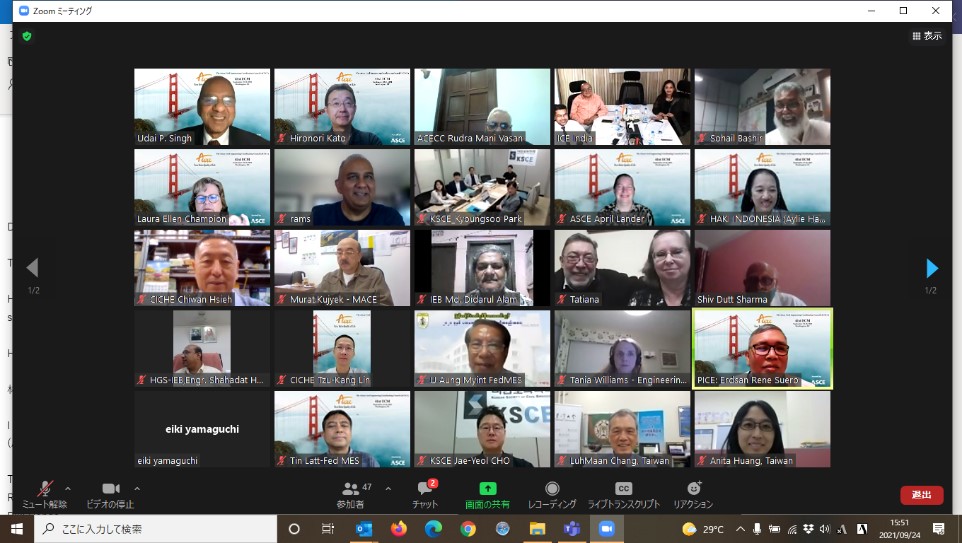IAC News
IAC News No.110, December 1 2021
Japan Society of Civil Engineers International Activities Center December 1, 2021 IAC News No.110
The 3rd JSCE-CCES Joint Symposium
In 2014, to mark the 100th anniversary since the founding of JSCE, Professor Masahiko Isobe, then president of JSCE, and Professor Yong-Sheng Li, Vice President of the Chinese Civil Engineering Society (CCES), held talks on holding a joint symposium to strengthen ties between the two societies and agreed to take turns in hosting a symposium to create opportunities to visit and learn from each other. Following this agreement, the relevant personnel at both societies proceeded with preparations. The first joint symposium was held at the JSCE Hall in Tokyo in October 2016, while the second joint symposium was held at Tongji University in Shanghai in October 2018.
At the 1st JSCE-CCES Joint Symposium, researchers and field experts from both countries presented their research on the theme of bridges and tunnels. Furthermore, the relevant personnel of both societies gathered to report on their preparations and procedures for the event, and at the same time, discussed plans for the next symposium. The topics of forming a network of attendees and ensuring the research and discussions continued were the first matters examined, and it was proposed and agreed that both societies would each hold this symposium once based on a common theme.
This symposium, which marked the third time in the event’s history, was scheduled to be held in Japan in 2020, but the date was pushed back by a year due to the impact of the COVID-19 pandemic, and ultimately, it was held online on October 20 and 21, 2021.
The theme for this symposium was focused on hydraulic engineering and coastal engineering, and JSCE collaborated with the Committee on Hydroscience and Hydraulic Engineering and the Coastal Engineering Committee, while CCES collaborated with Tongji University and Hohai University to create a program for the event. As a result of these efforts to create a program, the symposium was a content-packed event, consisting of keynote lectures by 4 people, 37 research presentations in 7 sessions, and lectures by 6 people in a special session. There were 24 research presentations from JSCE and 22 from CCES, while the special session covered flood disasters that occurred in Japan, China, Europe, and the United States this summer. The symposium also welcomed researchers from the American Society of Civil Engineers (ASCE) in addition to those from Japan and China.
The first day (Oct. 20) of the two-day event began with welcoming words from the two chairs Professor Hitoshi Tanaka (Tohoku University), Senior Director of the JSCE International Activities Center who also served as moderator for the event, and Professor Gu Xianglin, Associate Chancellor of Tongji University, as well as Professor Tamon Ueda (Shenzhen University), the JSCE President-Elect (Photo 1). Opening ceremony attendees then discussed the direction of the theme of the joint symposium, a rare spectacle at an opening ceremony, but nonetheless, the symposium kicked off with smiles and laughter all around.
The moderator then handed proceedings over to Professor Yasuto Tachikawa of Kyoto University and the keynote speeches got underway. Professor Shinjiro Kanae of the Tokyo Institute of Technology and Professor Feng Jin of Tsinghua University explained their advanced researches and the future challenges in the field of hydraulic engineering in an easy-to-understand manner, with those in attendance on the edge of their seats to catch every word of this fascinating talk.
Following a break, next up saw parallel sessions on the hydroengineering field and the coastal engineering field. Attendees were divided up into the aforementioned two fields and joined each session (Zoom room) to present their research and engage in discussions (Photo 2). Despite the physical distance between China and Japan, the Zoom room closed the gap between the attendees, with each person presenting their research, asking what others thought on issues, and actively engaging in discussions.
After the parallel sessions, the aforementioned special session was held, with researchers from Japan, China, and New Zealand introducing the causes of floods, the state of damage, and the measures taken by each government regarding floods caused by torrential rain that have led to an enormous amount of damage all over the world. The special session also saw attendees discuss the technical challenges of responding to such disasters in the future while considering the social environment and systems of each country as well as how to ensure the safety of the local people and so on.
Day-two of the symposium (Oct. 21) began with organizing committee adviser Professor Feng Zhang of Nagoya Institute of Technology, who served as moderator for the day, introduce Professor Jinhai Zheng, Associate Chancellor of Hohai University, and Professor Jun Sasaki of the University of Tokyo for their keynote lectures (Photo 4).
During the closing ceremony, Da Chen, chairperson of the symposium’s organizing committee and professor at Hohai University, summarized proceedings and gave a few final words. Before the curtain was pulled down on the two-day event, the attendees were asked to turn on their cameras so that a commemorative photo could be taken (Photo 5).
The 4th JSCE-CCES Joint Symposium is set to go ahead in Nanjing in 2023 based on the theme of hydraulic engineering and coastal engineering, and the 5th JSCE-CCES Joint Symposium will be held in Japan again in 2025 with an even broader theme. We will create an event program that many people can sink their teeth into. Thank you for your continued support and cooperation in making the JSCE-CCES Joint Symposium a great success.
<
Photo1 Opening Ceremony

Photo2 A Session of Hydro Engineering

Photo3 Special Session

Photo4 Keynote Speakers

Photo5 Closing Ceremony
※This Symposium was supported by International Scientific Exchange Fund.
【Reported by Reported by Ji Dang, International Communication & Collaboration Group (Saitama University)】
Japanese Civil Engineers the Global Leaders Symposium Series No. 19
“Overseas Expansion in the Running of Transportation Infrastructure”
On November 9, 2021, the Japanese Civil Engineers the Global Leaders Symposium Series No. 19 “Overseas Expansion in the Running of Transportation Infrastructure” was held by the JSCE International Activities Center. So far, this symposium series has introduced the activities of Japanese civil engineers on a project-by-project basis. However, in the Ministry of Land, Infrastructure, Transport and Tourism’s efforts to roll out infrastructure overseas, Japanese companies are required to play an active role not only in the construction and maintenance of infrastructure but also in its operation, an entire series of operations known as “upstream to downstream.” While there are various schemes to establish infrastructure such as BOT (build-operate-transfer), we civil engineers are required to understand not only about establishing infrastructure but also its operation and maintenance as an entire package. That is why on this occasion, I decided to introduce cases in the transportation sector under the theme of infrastructure management.
At the symposium, following the welcome of President-Elect Tamon Ueda, Kei Owada, Deputy Director of the Japan International Cooperation Agency (JICA) Private Sector Partnership and Finance Department, reported on the latest situation regarding the financing of infrastructure development. Kunihiko Oshima, Executive Officer of Kumagai Gumi Co., Ltd., Junji Kawasaki, General Manager of East Japan Railway Co., Ltd., and Hidetoshi Kume, Director of Japan Port Transport Association, gave an introduction of various approaches in operating infrastructure such as BOT projects, maintenance projects, and investment projects in the areas of roads and highways, railways, and ports. At the end of the symposium, Yoshiaki Higuchi, Director of the International Activities Center, gave a summary of the event’s proceedings. Along with the introduction of each project, there was a lively question and answer session, making it a three-hour session packed with content.
In addition to the fact that it was held entirely online, a growing interest in overseas infrastructure management meant this symposium received 431 attendance applications prior to the event, exceeding the number of applications of the previous symposium.
Regarding the running of overseas transportation infrastructure, it is presumed that many projects face the issue of securing demand for the project due to the impact of the COVID-19 pandemic. Going forward, in order to ensure the sound development of overseas transportation infrastructure, us civil engineers need to pay attention to the management and operation of infrastructure and play an active role in these parts of the overall process.
Next time, this Global Leaders Symposium Series will celebrate the landmark of reaching its 20th symposium since the event first began back in 2014. I would like to ask for your continued support as well as your thoughts regarding the symposium so that I can continue to deliver a successful event to all attendees.
【Reported by Masaru Suzuki, Project Group Leader, IAC】
Asian Civil Engineering Coordinating Council (ACECC)
41st Executive Committee Meeting in Washington DC
1. Overview
ACECC (Asian Civil Engineering Coordinating Council) is an organization established in September 1999 to improve and develop sustainable social capital in the Asian region. At present, 15 civil engineering-related societies are affiliated with the ACECC, with the organization engaged in various activities to promote learning and skills with the cooperation of those societies. The 41st Executive Committee Meeting was hosted by the American Society of Civil Engineers (ASCE) and was held online on September 23 and 24, 2021 (Photo 1). In addition to the Executive Committee Meeting, two seminars hosted by the Technical Committee (TC) and the Future Leaders Forum (FLF) were held at the same time. This is a report on the main contents of the meeting and seminars.
2. Technical Coordination Committee Meeting (TCCM)
The Technical Coordination Committee Meeting consisted of reports on the activities of nine TCs currently engaged in activities, as well as a report on the status of the Special Session held at the JSCE Annual Meeting and the plan of activities for the 9th Civil Engineering Conference in Asian Region (CECAR9) given by TC Chair, Mikio Ishiwatari (JICA and the University of Tokyo) in relation to TC21 (Transdisciplinary Approach for Building Societal Resilience to Disasters), for which JSCE that approved the contents of each report acts as the chair country.
In addition, JSCE proposed a new TC called “Application of Monitoring Technology for Infrastructure Maintenance.” The purpose of this TC is to aid the widespread adoption of more sophisticated and efficient maintenance through the effective use of monitoring technologies around the Asian region. As research outsourced from the Research Association for Infrastructure Monitoring System (RAIMS), the TC is based on the monitoring guidelines compiled by the Subcommittee on Promoting the Application of New Technologies, which is positioned under the Organization for Promotion of Civil Engineering Technology, JSCE. At the TCCM, a proposal was made by Masaaki Nakano, a committee member and director (Nippon Koei Co., Ltd.) who is in charge of this TC. Following the proposal, the TC was given the green light as TC28.
3. Planning Committee Meeting (PCM)
Regarding the status of preparations for CECAR9 to be held in Goa, India in September 2022, the Local Organizing Committee (LOC) reported that, because we have seemingly overcome the worst of the COVID-19 pandemic and the number of infections is decreasing rapidly, it is considering holding a full in-person event locally. Representative Prof. Hironori Kato, Committee on Asian Civil Engineering Coordinating Council, JSCE responded to this by suggesting that since it is unclear whether the worst of the COVID-19 pandemic is over, it would be risky to plan only an in-person event and that the committee should consider a hybrid-style event that contains both online and in-person elements. As a result of this suggestion, it was decided that the matter would be discussed again at the ECM the following day.
The 42nd Executive Committee Meeting, which was scheduled to be hosted by the Federation of Myanmar Engineering Society (Fed. MES) in March or April 2022, will be held by the Indonesian Society of Civil and Structural Engineers (HAKI) because the political unrest in Myanmar is ongoing.
4. Executive Committee Meeting (ECM)
At the ECM, the decisions made at the TCCM and PCM were approved. Regarding the proposal to hold CECAR9 as an entirely in-person event, JSCE Representative Eiki Yamaguchi also reiterated the need to consider holding a hybrid-style event that contained both in-person and online elements. In response to this, the LOC and ACECC secretariats decided to revise the plan as soon as possible, and it was decided that an ad-hoc ECM would be held.
5. TC Seminars and Future Leaders Forum
TC17 (Ethical Practices to Reduce Corruption) examined the Code of Ethics of ACECC, with ASCE playing a central role. A committee member Tomohiro Ono (JICA) participated on behalf of JSCE. This seminar consisted of an introduction of rough plans as well as discussions.
The TC14 (Sustainable Infrastructure) Seminar was held following on from the previous ECM. Participating from JSCE was Yoshinori Fukubayashi (University of Miyazaki), a member in charge of TC14 of the Committee on Asian Civil Engineering Coordinating Council. This time, eight countries including Nepal reported on their level of achievement based on the “Sustainable Development Report 2021”, an international report published in June 2021 that discusses the achievement and progress of the SDGs.
Established as a forum for exchanging opinions with young leaders who will one day shoulder responsible for the future development of civil engineering in the Asian region, the Future Leaders Forum (FLF) saw participation from JSCE member Ms. Rajali Maharjan (Transportation Research Institute), who is a FLF representative of the Committee on Asian Civil Engineering Coordinating Council. During the forum, Chair of the Future Leaders Committee (FLC) Ms. Prasanti Widyasih Salri (HAKI) introduced FLC members, the status of activities, and the policy for activities going forward. Next, representatives from the Philippines and Bangladesh introduced their efforts under the theme of “Innovation in Civil Engineering from around Asia.”
6. Conclusion
Ms. Meggan Maughan-Brown, who has assisted ACECC’s activities for 25 years, retired as ASCE’s ACECC representative at the end of June. I would like to express my sincere gratitude to Ms. Maughan-Brown for all her efforts. She won the hearts of many ACECC officials during her 25 years of loyal service. I would also like to pay tribute to the ASCE officials who ran this ECM, working late into the night to ensure coordination went smoothly despite the time differences in the Asian region.


Photo 1 ASCE President Briaud Welcomes Attendees during the ECM
【Reported by Jun Izawa, Secretary-General, the Committee on Asian Civil Engineering Coordinating Council】
Updates
- International Joint Seminar on ADVANCES IN CIVIL ENGINEERING "Applications of Advanced Materials and Machine Learning in Civil Engineering" (December 4) https://www.youtube.com/watch?v=LDrr5zqJ4c8
Japanese: https://www.youtube.com/watch?v=0A5ScjsHwKo - Open the door wide and bring diverse perspectives into the civil engineering community!
https://committees.jsce.or.jp/diversity/node/78 - Japan Construction International Award:
Japanese Quality Infrastructure Surprises Samurai, Ninja and Geisha https://youtu.be/gZBQe5IqAyw - Japan's Infrastructure Grades 2020 & Introduction of Maintenance Technologies
https://www.jsce-int.org/node/733 - Japan Construction International Award
https://www.mlit.go.jp/JCIA/en/ - ICHARM Webinar 2021; https://www.pwri.go.jp/icharm/special_topic/ICHARM_webinar_2021.html
- American Society of Civil Engineers(ASCE)
・ASCE Lifeline Conference 2021 2022
Dates updated: Jan 31-Feb 4, 2022
https://samueli.ucla.edu/lifelines2021/
・Joint Japan-US Symposium on Assessment, Management, and Governance for Infrastructure Resilience
*Pre-recorded Presentation Available on the Website.
https://www.infraresil.jp/event/01/ - The International Infrastructure Archives
– A Compilation of Japan’s Greatest Projects in Transfer of Civil Engineering Technology in Service –
http://www.jsce.or.jp/e/archive/ - IAC “News Pick Up!!” on the JSCE Japanese website
https://committees.jsce.or.jp/kokusai/iac_dayori_2021 - Summary of featured articles in JSCE Magazine Vol. 106, No.12, December 2021
http://www.jsce-int.org/pub/magazine - Journal of JSCE
https://www.jstage.jst.go.jp/browse/journalofjsce
IAC News Subscription
The IAC News is one of the communication tools to share information and ideas with the members. We would like to invite you, your friends and colleagues to join the communication and to subscribe the IAC News. Please register online: (http://www.jsce-int.org/node/150). We look forward to meeting you.
